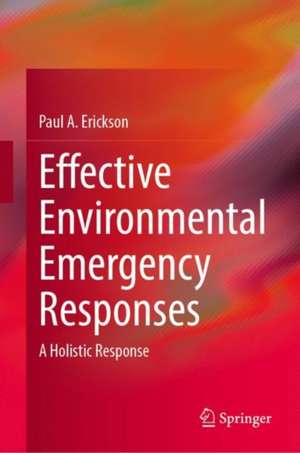Effective Environmental Emergency Responses: A Holistic Response
Autor Paul A. Ericksonen Limba Engleză Hardback – 19 iul 2022
The book is essentially a critique of contemporary emergency response which, in both the public perception and, unfortunately, in the mind-set of many practicing professionals emphasizes an emergency as a singular event. It is a mistaken view: an emergency is actually a sequence of multiple, singular events that unfold over time, sometimes measured in days and weeks and, most often, in months, years and decades.
This book focuses on the need, in the current and recent past generation to revamp our thinking about planning for and responding comprehensively to those periodic disruptions to daily routine we call "emergencies".
| Toate formatele și edițiile | Preț | Express |
|---|---|---|
| Paperback (1) | 730.13 lei 38-44 zile | |
| Springer International Publishing – 20 iul 2023 | 730.13 lei 38-44 zile | |
| Hardback (1) | 892.28 lei 3-5 săpt. | |
| Springer International Publishing – 19 iul 2022 | 892.28 lei 3-5 săpt. |
Preț: 892.28 lei
Preț vechi: 1088.15 lei
-18% Nou
Puncte Express: 1338
Preț estimativ în valută:
170.74€ • 186.04$ • 143.87£
170.74€ • 186.04$ • 143.87£
Carte disponibilă
Livrare economică 02-16 aprilie
Preluare comenzi: 021 569.72.76
Specificații
ISBN-13: 9783031058929
ISBN-10: 3031058925
Pagini: 174
Ilustrații: X, 174 p. 1 illus.
Dimensiuni: 155 x 235 mm
Greutate: 0.48 kg
Ediția:1st ed. 2022
Editura: Springer International Publishing
Colecția Springer
Locul publicării:Cham, Switzerland
ISBN-10: 3031058925
Pagini: 174
Ilustrații: X, 174 p. 1 illus.
Dimensiuni: 155 x 235 mm
Greutate: 0.48 kg
Ediția:1st ed. 2022
Editura: Springer International Publishing
Colecția Springer
Locul publicării:Cham, Switzerland
Cuprins
PART I: Overview. Chapter1. Introduction.- Chapter2. Measuring Success and Failure of Response.- Chapter3. Logistics: Expertise, Personnel, Equipment, Supplies.- PART II: Lessons Learned; Lessons Applied. Chapter4. Wildfire.- Chapter5.Pandemic.- Chapter 6.Hurricane.- Chapter7. Domestic Terrorism.- Chapter8. Earthquake.- Chapter 9. Climate Change.- PART III: Social-Structural Considerations. Chapter 10. On the Scope of Emergency Planning.- Chapter 11.Consensus vs. Conflict.- Chapter 12.Epilogue.-Appendices.- References.
Notă biografică
Paul A. Erickson, a former Fulbright Scholar, served as an independent consultant (environmental science; occupational health and safety, and emergency management) for 25 years prior to joining Anna Maria College where he has since served as a teacher for the last 21 years. He has authored a number of technical texts and has authored the Emergency Response Planning for Corporate and Municipal Managers. Dr. Erickson has lectured for Federal agencies throughout the United States, and has also lectured on a variety of scientific and technical topics throughout South East Asia.
Textul de pe ultima copertă
This book focuses on the variety of subsequent consequences that may follow the conclusion of the immediate emergency response effort, consequences that require multi-disciplinary efforts and most likely may require a revamping of the historical interplay of national and other political authorities.
The book is essentially a critique of contemporary emergency response which, in both the public perception and, unfortunately, in the mind-set of many practicing professionals emphasizes an emergency as a singular event. It is a mistaken view: an emergency is actually a sequence of multiple, singular events that unfold over time, sometimes measured in days and weeks and, most often, in months, years and decades.
This book focuses on the need, in the current and recent past generation to revamp our thinking about planning for and responding comprehensively to those periodic disruptions to daily routine we call "emergencies".
The book is essentially a critique of contemporary emergency response which, in both the public perception and, unfortunately, in the mind-set of many practicing professionals emphasizes an emergency as a singular event. It is a mistaken view: an emergency is actually a sequence of multiple, singular events that unfold over time, sometimes measured in days and weeks and, most often, in months, years and decades.
This book focuses on the need, in the current and recent past generation to revamp our thinking about planning for and responding comprehensively to those periodic disruptions to daily routine we call "emergencies".
Caracteristici
A focus on emergency planners and managers of a comprehensive response effort
Includes numerous graphics with relevant take’ home messages’ from each chapter
Case studies provide insights into planning and effective emergency responses
Includes numerous graphics with relevant take’ home messages’ from each chapter
Case studies provide insights into planning and effective emergency responses
